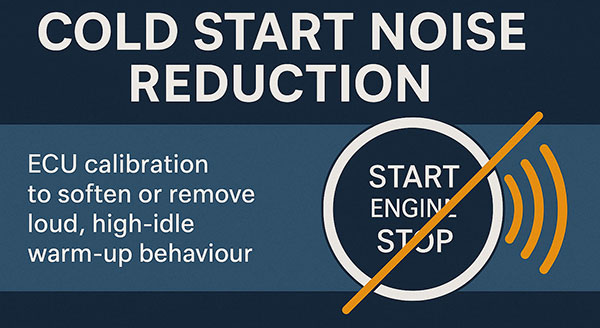Cold start noise reduction is an ECU calibration that softens or removes the loud, high-idle warm-up behaviour present on many modern petrol engines. It refines cold-start enrichment, idle and ignition strategies so the engine starts more quietly and smoothly, especially important for tuned cars in residential or enclosed environments.
Cold Start Noise Reduction

Cold Start Noise Reduction Explained
The Cold Start Noise Reduction calibration disables or softens the ECU cold-start routine that enriches fueling, raises idle RPM and retards ignition while lambda sensors warm up. This sequence accelerates catalyst heating but often produces a loud exhaust note and rough idle for 30–90 seconds. By refining those strategies at software level—no hardware changes needed—the engine starts more quietly and smoothly.
Modern ECUs run multiple concurrent subroutines during cold start: open-loop enrichment, idle-air torque adders, ignition retard for catalyst light-off, and sometimes secondary-air injection. Cold start noise reduction adjusts these maps to reduce unnecessary noise while keeping drivability and reliability intact once the engine is warm.
Learn more about cold-start behaviour on
Wikipedia.
When to Use
- After installing a sport or decat exhaust and wanting a quieter morning start-up.
- When OEM calibration produces aggressive idle flare or vibration.
- To reduce noise in enclosed or residential areas.
- On tuned petrol engines with overly rich warm-up maps.
Technical Details
Cold-start behaviour depends on:
- Fuel enrichment tables (mixture vs coolant temperature).
- Idle speed targets and torque adders.
- Ignition retard for fast catalyst light-off.
- Secondary-air injection behaviour.
The calibration trims enrichment and idle targets during warm-up, optimises ignition behaviour and aligns torque-related limiters. This results in quieter and smoother startups.
It integrates well with solutions like Exhaust Flap Removal and
Sport Displays Calibration.
How It Works
- Assessment: We analyse your current calibration and logs to quantify cold-start behaviour.
- Calibration: We prepare a refined cold start noise reduction file optimising fueling, idle and timing.
- Flash & Verify: Flash the file and confirm quieter, smoother startup performance.
Compatibility & Tooling
Supported on most petrol ECUs with controlled cold-start routines. Check live coverage below; if your ECU/ID is missing, send your read file and we will add support.
Cold_Start_Noise — Supported ECU
| Brand | ECU | Instructions |
|---|---|---|
| BMW | ||
| BMW | BOSCH MEVD17.2.3 | / |
| BMW | BOSCH MEVD17.2.4 | / |
| BMW | BOSCH MEVD17.2.5 | / |
| BMW | BOSCH MEVD17.2.6 | / |
| BMW | BOSCH MEVD17.2.8 | / |
| BMW | BOSCH MEVD17.2.9 | / |
| BMW | BOSCH MEVD17.2.G | / |
| BMW | BOSCH MEVD17.2.H | / |
| BMW | BOSCH MG1CS003 | / |
| BMW | BOSCH MG1CS024 | / |
| BMW | BOSCH MG1CS201 | / |
| BMW | SIEMENS MSD80 | / |
| BMW | SIEMENS MSD81 | / |
| BMW | SIEMENS MSD85 | / |
| BMW | SIEMENS MSS60 | / |
| Chevrolet | ||
| Chevrolet | BOSCH MED9.6.1 | / |
| Jaguar | ||
| Jaguar | BOSCH MED17.8.31 | / |
| Lamborghini | ||
| Lamborghini | BOSCH MED17.1.1 | / |
| Mercedes | ||
| Mercedes | BOSCH MED17.7.2 | / |
| Mini | ||
| Mini | BOSCH MEVD17.2.3 | / |
| Porsche | ||
| Porsche | BOSCH MG1CP007 | / |
| Porsche | BOSCH MG1CS002 | / |
| Psa (Citroen/Peugeot/Ds) | ||
| Psa (Citroen/Peugeot/Ds) | VALEO VD56.1 | / |
| Vag (Audi/Skoda/Seat/Volkswagen/Cupra) | ||
| Vag (Audi/Skoda/Seat/Volkswagen/Cupra) | BOSCH MED17.1 | / |
| Vag (Audi/Skoda/Seat/Volkswagen/Cupra) | BOSCH MED17.1.1 | / |
| Vag (Audi/Skoda/Seat/Volkswagen/Cupra) | BOSCH MED17.1.62 | / |
| Vag (Audi/Skoda/Seat/Volkswagen/Cupra) | BOSCH MED9.1 | / |
| Vag (Audi/Skoda/Seat/Volkswagen/Cupra) | BOSCH MED9.1.1 | / |
| Vag (Audi/Skoda/Seat/Volkswagen/Cupra) | BOSCH MG1CS002 | / |
| Vag (Audi/Skoda/Seat/Volkswagen/Cupra) | BOSCH MG1CS031 | / |
| Vag (Audi/Skoda/Seat/Volkswagen/Cupra) | CONTINENTAL SIMOS 12.1 | / |
| Vag (Audi/Skoda/Seat/Volkswagen/Cupra) | CONTINENTAL SIMOS 12.2 | / |
For more ECU strategies, visit the
ECU Services coverage.
Practical Notes & Safety
Cold start noise reduction must be matched to ambient climate and hardware. Extremely short warm-up in freezing climates may affect catalyst efficiency. Mechanical health (injectors, lambda sensors, exhaust sealing) must be verified before applying the calibration. Use only where permitted by local regulations.
